cooling Hyundai Sonata
[x] Cancel search | Manufacturer: HYUNDAI, Model Year: , Model line: , Model:Pages: 285, PDF Size: 9.38 MB
Page 14 of 285
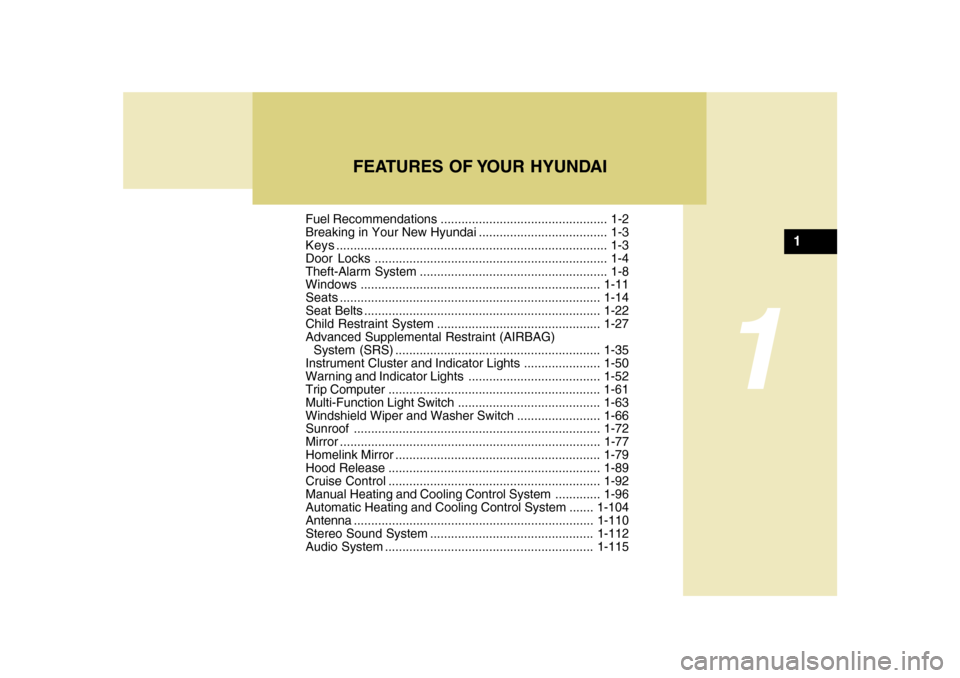
1
Fuel Recommendations ................................................ 1-2
Breaking in Your New Hyundai ..................................... 1-3
Keys.............................................................................. 1-3
Door Locks ................................................................... 1-4
Theft-Alarm System ...................................................... 1-8
Windows..................................................................... 1-11
Seats........................................................................... 1-14
Seat Belts.................................................................... 1-22
Child Restraint System ............................................... 1-27
Advanced Supplemental Restraint (AIRBAG)
System (SRS) ........................................................... 1-35
Instrument Cluster and Indicator Lights ...................... 1-50
Warning and Indicator Lights ...................................... 1-52
Trip Computer ............................................................. 1-61
Multi-Function Light Switch ......................................... 1-63
Windshield Wiper and Washer Switch ........................ 1-66
Sunroof....................................................................... 1-72
Mirror ...........................................................................1-77
Homelink Mirror ........................................................... 1-79
Hood Release ............................................................. 1-89
Cruise Control ............................................................. 1-92
Manual Heating and Cooling Control System ............. 1-96
Automatic Heating and Cooling Control System....... 1-104
Antenna.....................................................................1-110
Stereo Sound System...............................................1-112
Audio System............................................................1-115
FEATURES OF YOUR HYUNDAI
1
Page 71 of 285
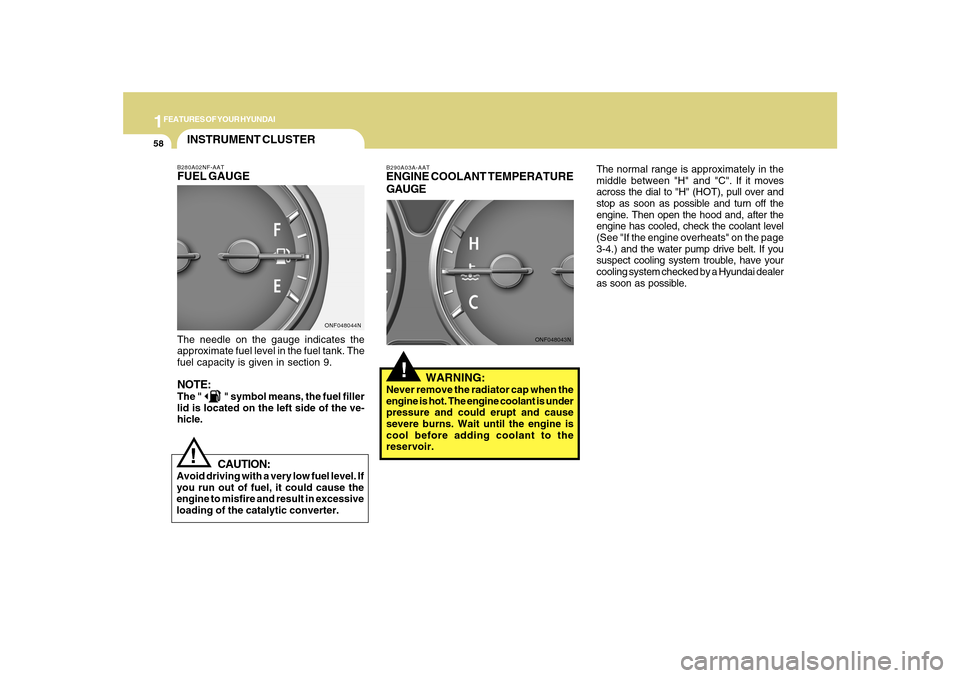
1FEATURES OF YOUR HYUNDAI58
!
B290A03A-AATENGINE COOLANT TEMPERATURE
GAUGE
WARNING:Never remove the radiator cap when the
engine is hot. The engine coolant is under
pressure and could erupt and cause
severe burns. Wait until the engine is
cool before adding coolant to the
reservoir.The normal range is approximately in the
middle between "H" and "C". If it moves
across the dial to "H" (HOT), pull over and
stop as soon as possible and turn off the
engine. Then open the hood and, after the
engine has cooled, check the coolant level
(See "If the engine overheats" on the page
3-4.) and the water pump drive belt. If you
suspect cooling system trouble, have your
cooling system checked by a Hyundai dealer
as soon as possible.
ONF048043N
INSTRUMENT CLUSTERB280A02NF-AATFUEL GAUGEThe needle on the gauge indicates the
approximate fuel level in the fuel tank. The
fuel capacity is given in section 9.NOTE:The "
" symbol means, the fuel filler
lid is located on the left side of the ve-
hicle.
ONF048044N
CAUTION:
Avoid driving with a very low fuel level. If
you run out of fuel, it could cause the
engine to misfire and result in excessive
loading of the catalytic converter.
!
Page 109 of 285
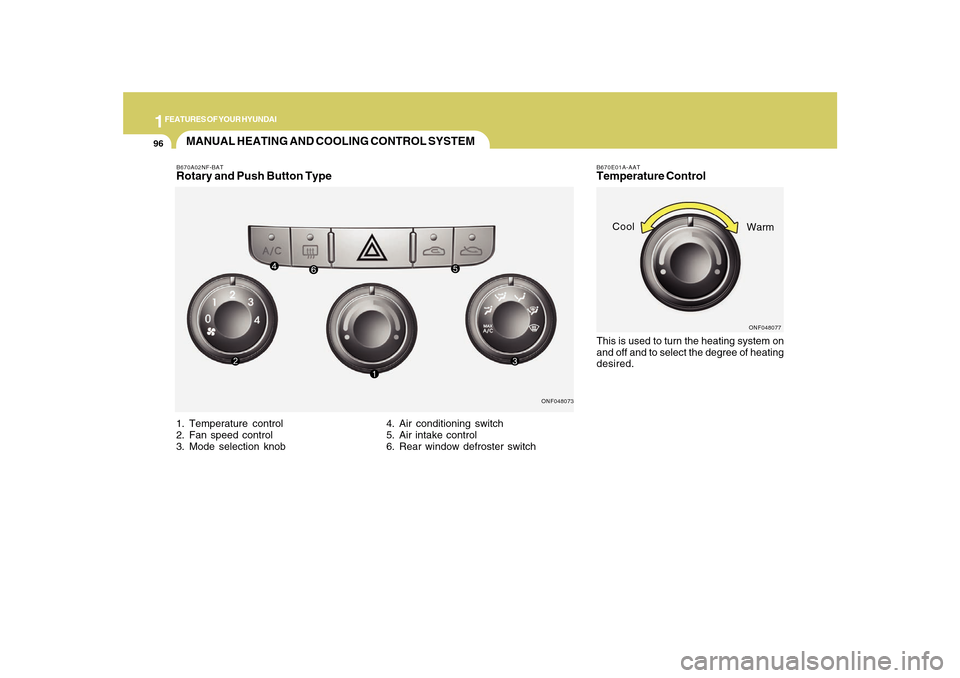
1FEATURES OF YOUR HYUNDAI96
B670E01A-AATTemperature ControlThis is used to turn the heating system on
and off and to select the degree of heating
desired.
ONF048077
Cool
Warm
MANUAL HEATING AND COOLING CONTROL SYSTEM1. Temperature control
2. Fan speed control
3. Mode selection knob
ONF048073
4. Air conditioning switch
5. Air intake control
6. Rear window defroster switch
B670A02NF-BATRotary and Push Button Type
Page 114 of 285
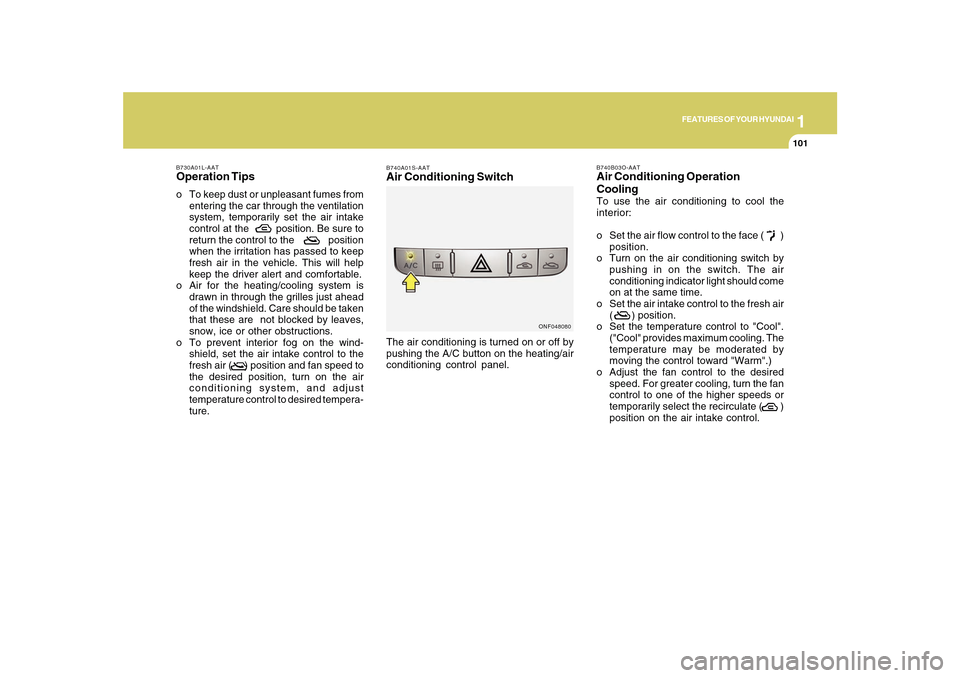
1
FEATURES OF YOUR HYUNDAI
101101
B730A01L-AATOperation Tipso To keep dust or unpleasant fumes from
entering the car through the ventilation
system, temporarily set the air intake
control at the position. Be sure to
return the control to the position
when the irritation has passed to keep
fresh air in the vehicle. This will help
keep the driver alert and comfortable.
o Air for the heating/cooling system is
drawn in through the grilles just ahead
of the windshield. Care should be taken
that these are not blocked by leaves,
snow, ice or other obstructions.
o To prevent interior fog on the wind-
shield, set the air intake control to the
fresh air ( ) position and fan speed to
the desired position, turn on the air
conditioning system, and adjust
temperature control to desired tempera-
ture.
B740A01S-AATAir Conditioning SwitchThe air conditioning is turned on or off by
pushing the A/C button on the heating/air
conditioning control panel.
ONF048080B740B03O-AAT
Air Conditioning Operation
CoolingTo use the air conditioning to cool the
interior:
o Set the air flow control to the face ( )
position.
o Turn on the air conditioning switch by
pushing in on the switch. The air
conditioning indicator light should come
on at the same time.
o Set the air intake control to the fresh air
( ) position.
o Set the temperature control to "Cool".
("Cool" provides maximum cooling. The
temperature may be moderated by
moving the control toward "Warm".)
o Adjust the fan control to the desired
speed. For greater cooling, turn the fan
control to one of the higher speeds or
temporarily select the recirculate ( )
position on the air intake control.
Page 117 of 285
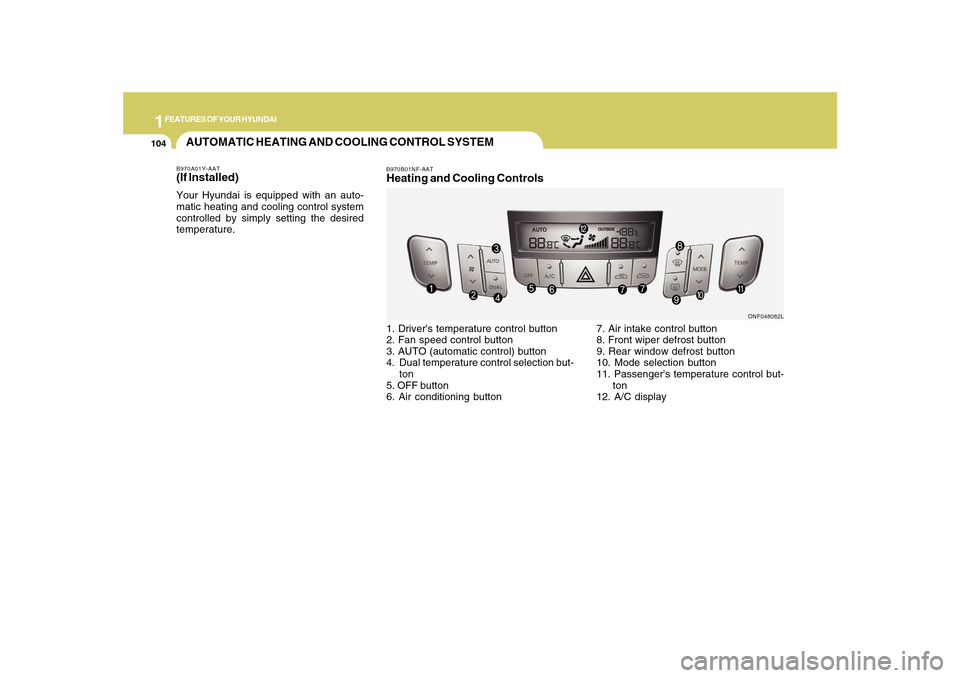
1FEATURES OF YOUR HYUNDAI
104
AUTOMATIC HEATING AND COOLING CONTROL SYSTEMB970A01Y-AAT(If lnstalled)Your Hyundai is equipped with an auto-
matic heating and cooling control system
controlled by simply setting the desired
temperature.
B970B01NF-AATHeating and Cooling Controls1. Driver's temperature control button
2. Fan speed control button
3. AUTO (automatic control) button
4. Dual temperature control selection but-
ton
5. OFF button
6. Air conditioning button7. Air intake control button
8. Front wiper defrost button
9. Rear window defrost button
10. Mode selection button
11. Passenger's temperature control but-
ton
12. A/C display
ONF048082L
Page 118 of 285
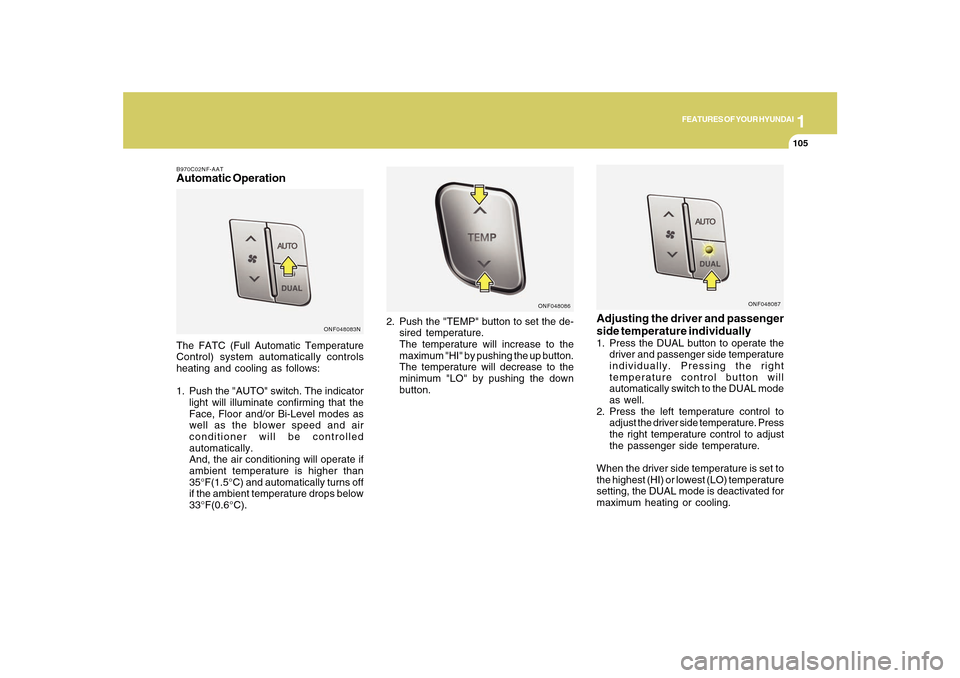
1
FEATURES OF YOUR HYUNDAI
105105
B970C02NF-AATAutomatic OperationThe FATC (Full Automatic Temperature
Control) system automatically controls
heating and cooling as follows:
1. Push the "AUTO" switch. The indicator
light will illuminate confirming that the
Face, Floor and/or Bi-Level modes as
well as the blower speed and air
conditioner will be controlled
automatically.
And, the air conditioning will operate if
ambient temperature is higher than
35°F(1.5°C) and automatically turns off
if the ambient temperature drops below
33°F(0.6°C).2. Push the "TEMP" button to set the de-
sired temperature.
The temperature will increase to the
maximum "HI" by pushing the up button.
The temperature will decrease to the
minimum "LO" by pushing the down
button.
ONF048083NONF048086
ONF048087
Adjusting the driver and passenger
side temperature individually1. Press the DUAL button to operate the
driver and passenger side temperature
individually. Pressing the right
temperature control button will
automatically switch to the DUAL mode
as well.
2. Press the left temperature control to
adjust the driver side temperature. Press
the right temperature control to adjust
the passenger side temperature.
When the driver side temperature is set to
the highest (HI) or lowest (LO) temperature
setting, the DUAL mode is deactivated for
maximum heating or cooling.
Page 119 of 285
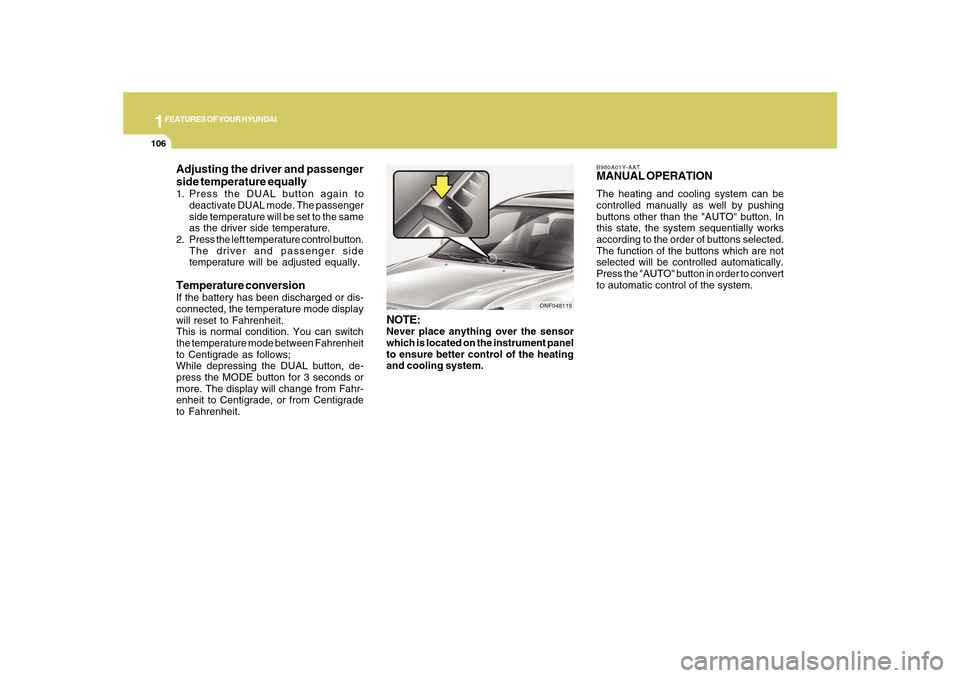
1FEATURES OF YOUR HYUNDAI
106
B980A01Y-AATMANUAL OPERATIONThe heating and cooling system can be
controlled manually as well by pushing
buttons other than the "AUTO" button. In
this state, the system sequentially works
according to the order of buttons selected.
The function of the buttons which are not
selected will be controlled automatically.
Press the "AUTO" button in order to convert
to automatic control of the system.
ONF048115
NOTE:Never place anything over the sensor
which is located on the instrument panel
to ensure better control of the heating
and cooling system.
Adjusting the driver and passenger
side temperature equally1. Press the DUAL button again to
deactivate DUAL mode. The passenger
side temperature will be set to the same
as the driver side temperature.
2. Press the left temperature control button.
The driver and passenger side
temperature will be adjusted equally.Temperature conversionIf the battery has been discharged or dis-
connected, the temperature mode display
will reset to Fahrenheit.
This is normal condition. You can switch
the temperature mode between Fahrenheit
to Centigrade as follows;
While depressing the DUAL button, de-
press the MODE button for 3 seconds or
more. The display will change from Fahr-
enheit to Centigrade, or from Centigrade
to Fahrenheit.
Page 121 of 285
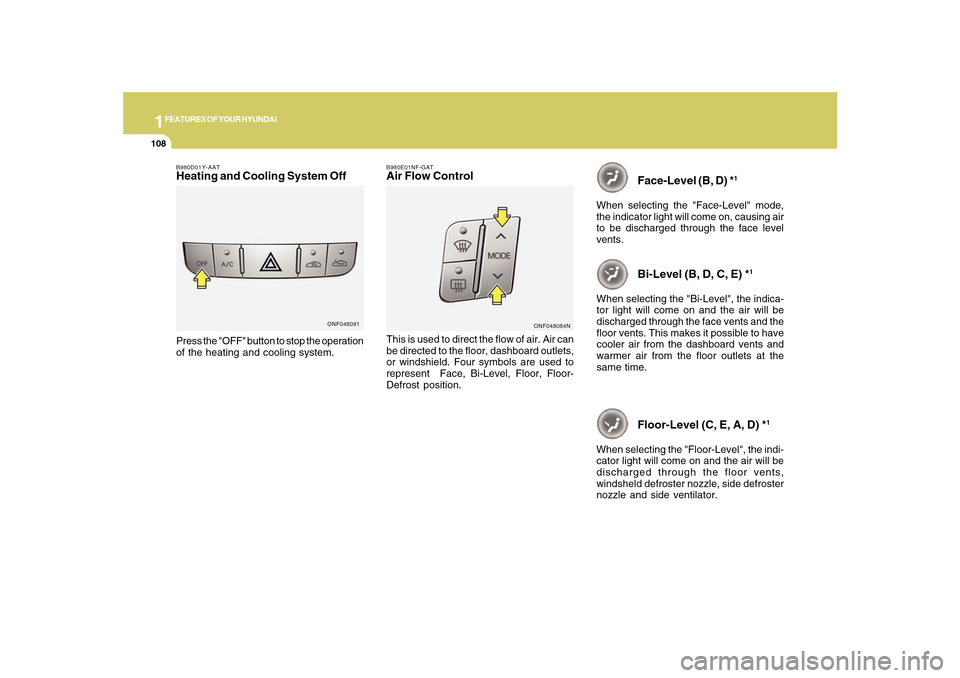
1FEATURES OF YOUR HYUNDAI
108
Face-Level (B, D) *
1
When selecting the "Face-Level" mode,
the indicator light will come on, causing air
to be discharged through the face level
vents.
B980D01Y-AATHeating and Cooling System OffPress the "OFF" button to stop the operation
of the heating and cooling system.
ONF048091B980E01NF-GAT
Air Flow ControlThis is used to direct the flow of air. Air can
be directed to the floor, dashboard outlets,
or windshield. Four symbols are used to
represent Face, Bi-Level, Floor, Floor-
Defrost position.
ONF048084N
Floor-Level (C, E, A, D) *
1
When selecting the "Floor-Level", the indi-
cator light will come on and the air will be
discharged through the floor vents,
windsheld defroster nozzle, side defroster
nozzle and side ventilator.
Bi-Level (B, D, C, E) *
1
When selecting the "Bi-Level", the indica-
tor light will come on and the air will be
discharged through the face vents and the
floor vents. This makes it possible to have
cooler air from the dashboard vents and
warmer air from the floor outlets at the
same time.
Page 170 of 285
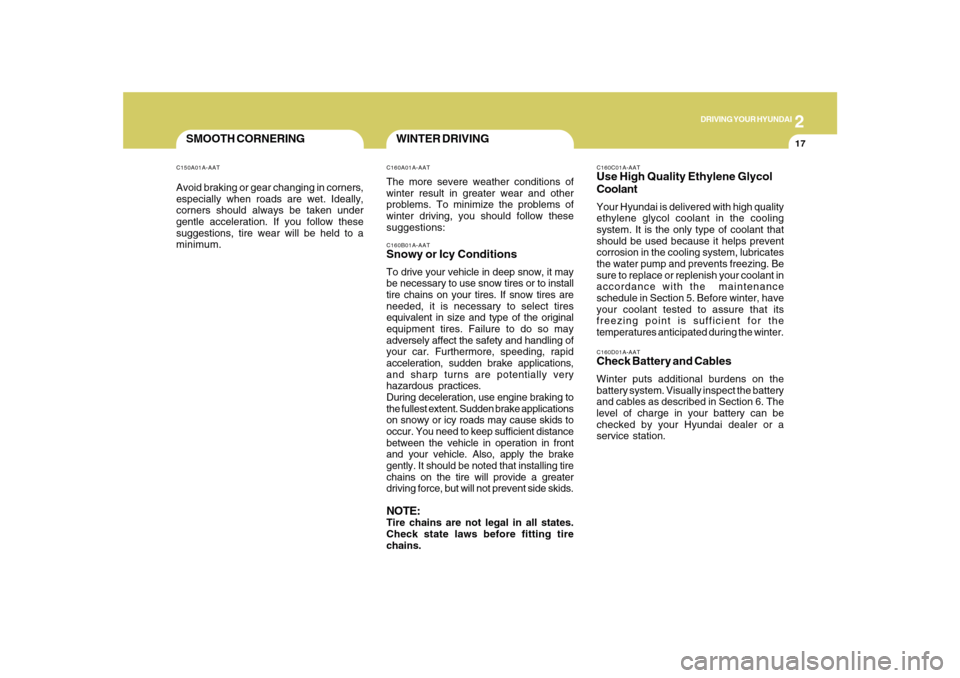
2
DRIVING YOUR HYUNDAI
17
SMOOTH CORNERINGC150A01A-AATAvoid braking or gear changing in corners,
especially when roads are wet. Ideally,
corners should always be taken under
gentle acceleration. If you follow these
suggestions, tire wear will be held to a
minimum.
C160A01A-AATThe more severe weather conditions of
winter result in greater wear and other
problems. To minimize the problems of
winter driving, you should follow these
suggestions:C160B01A-AATSnowy or Icy ConditionsTo drive your vehicle in deep snow, it may
be necessary to use snow tires or to install
tire chains on your tires. If snow tires are
needed, it is necessary to select tires
equivalent in size and type of the original
equipment tires. Failure to do so may
adversely affect the safety and handling of
your car. Furthermore, speeding, rapid
acceleration, sudden brake applications,
and sharp turns are potentially very
hazardous practices.
During deceleration, use engine braking to
the fullest extent. Sudden brake applications
on snowy or icy roads may cause skids to
occur. You need to keep sufficient distance
between the vehicle in operation in front
and your vehicle. Also, apply the brake
gently. It should be noted that installing tire
chains on the tire will provide a greater
driving force, but will not prevent side skids.NOTE:Tire chains are not legal in all states.
Check state laws before fitting tire
chains.WINTER DRIVING
C160D01A-AATCheck Battery and CablesWinter puts additional burdens on the
battery system. Visually inspect the battery
and cables as described in Section 6. The
level of charge in your battery can be
checked by your Hyundai dealer or a
service station.C160C01A-AATUse High Quality Ethylene Glycol
CoolantYour Hyundai is delivered with high quality
ethylene glycol coolant in the cooling
system. It is the only type of coolant that
should be used because it helps prevent
corrosion in the cooling system, lubricates
the water pump and prevents freezing. Be
sure to replace or replenish your coolant in
accordance with the maintenance
schedule in Section 5. Before winter, have
your coolant tested to assure that its
freezing point is sufficient for the
temperatures anticipated during the winter.
Page 185 of 285
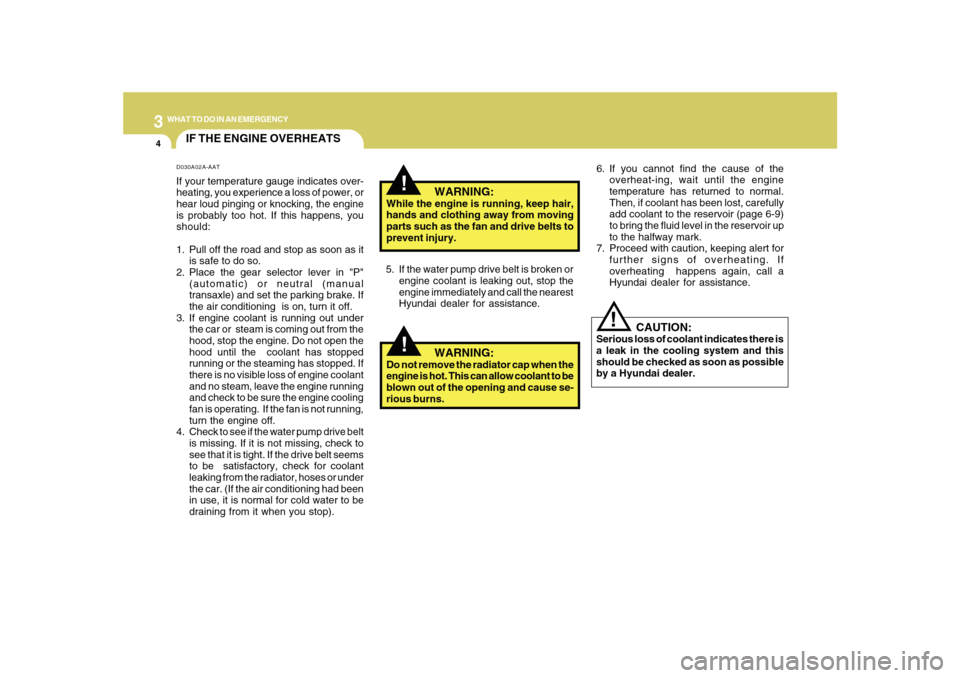
34WHAT TO DO IN AN EMERGENCY
IF THE ENGINE OVERHEATS
!!
!
WARNING:
While the engine is running, keep hair,
hands and clothing away from moving
parts such as the fan and drive belts to
prevent injury.
5. If the water pump drive belt is broken or
engine coolant is leaking out, stop the
engine immediately and call the nearest
Hyundai dealer for assistance.
WARNING:
Do not remove the radiator cap when the
engine is hot. This can allow coolant to be
blown out of the opening and cause se-
rious burns.6. If you cannot find the cause of the
overheat-ing, wait until the engine
temperature has returned to normal.
Then, if coolant has been lost, carefully
add coolant to the reservoir (page 6-9)
to bring the fluid level in the reservoir up
to the halfway mark.
7. Proceed with caution, keeping alert for
further signs of overheating. If
overheating happens again, call a
Hyundai dealer for assistance.
CAUTION:
Serious loss of coolant indicates there is
a leak in the cooling system and this
should be checked as soon as possible
by a Hyundai dealer.
D030A02A-AATIf your temperature gauge indicates over-
heating, you experience a loss of power, or
hear loud pinging or knocking, the engine
is probably too hot. If this happens, you
should:
1. Pull off the road and stop as soon as it
is safe to do so.
2. Place the gear selector lever in "P"
(automatic) or neutral (manual
transaxle) and set the parking brake. If
the air conditioning is on, turn it off.
3. If engine coolant is running out under
the car or steam is coming out from the
hood, stop the engine. Do not open the
hood until the coolant has stopped
running or the steaming has stopped. If
there is no visible loss of engine coolant
and no steam, leave the engine running
and check to be sure the engine cooling
fan is operating. If the fan is not running,
turn the engine off.
4. Check to see if the water pump drive belt
is missing. If it is not missing, check to
see that it is tight. If the drive belt seems
to be satisfactory, check for coolant
leaking from the radiator, hoses or under
the car. (If the air conditioning had been
in use, it is normal for cold water to be
draining from it when you stop).